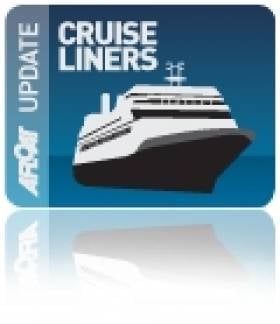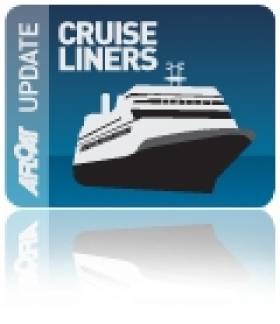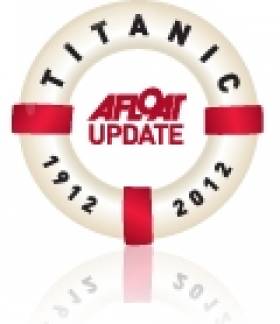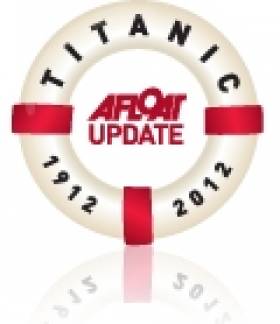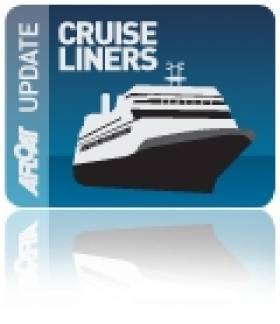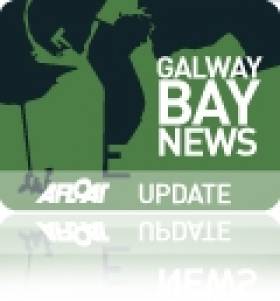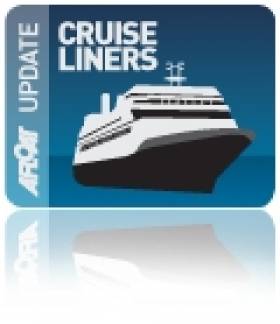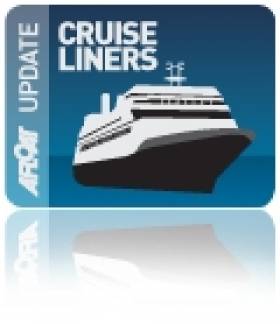Displaying items by tag: Cruiseships
Tweet, tweet! In case you missed them, here's a recap of the weekend's Irish sailing and boating top stories; An Irish superyacht steals the Show in France, Privateer does the same in Kinsale and there's a blustery start in Howth, NUI Galway enter the Round Ireland race, more humpback whales appear (we have the vid), an American sailor is looking for lost love in Ireland, the first cruise ship will arrive in Dun Laoghaire next week (and there's a new Dun Laoghaire dock installed to meet it) Young Finn Lynch from Blessington takes his place on the Irish Youth worlds team named here, there's a dramatic rescue on Fair head and tragically the search for two missing Irish sailors ends in San Francisco. Keep up to date via our twitter stream here
‘Lost Weight’ Cruiseship to Call to Dublin Port
#CRUISE LINERS – Following Friday's first cruise call to Dublin Port this year of the 300-plus passenger Arion as previously reported, the considerably larger Grand Princess is to call on Wednesday. Notably on this occasion the 2,600 passenger cruiseship is to appear without her signature 'Skywalker' Nightclub, which used to be perched 18 decks-high at the aft of the vessel, writes Jehan Ashmore.
The aptly named nightclub was built on two legs to form a bridge (see PHOTO) and was accessed by a glass gangway. Not only was the structure at such an elevated position but it also overhang beyond the sheer of the stern superstructure below, where clubbers had bird's eye views over the oceans and to numerous ports of calls.
In an operation to remove the Skywalker last year, the structure weighing 211 tons took over 10 hours to complete (as previously reported including VIDEO of the work). The reason for removing the nightclub according to her owners Princess Cruises was to 'significantly improve the operational performance of the ship, including greater fuel efficiency.' For a post dry-docking view click PHOTO.
During the procedure at the Grand Bahama Shipyard in the US, the opportunity included the installation of a new nightclub three decks below and was named One5.
Ironically before the vessel lost weight!....she was the first cruiseship to visit Dublin Port to surpass the 100,000 tonnes milestone, when the leadship of the 'Grand' class docked in 2004.
From Falmouth to the Fjords
#CRUISE LINERS – Dublin Port's first cruise caller for this season will be Arion which today sets sail from Falmouth on an eleven night / twelve day cruise to Scotland and Norwegian fjords. The 5,888 gross tonnes cruiseship built in 1965 is to berth in the capital at Ocean Pier, writes Jehan Ashmore.
The veteran vessel which has sleek traditional lines can carry over 300 passengers and she is operated by Classic International Cruises. Her visit will be one of around 90 cruise calls scheduled to Dublin Port during this year's season which stretches to early October. The majority of these calls will be in the summer and where several ships will be making repeat port of calls.
With so many callers to Dublin Port, this brings a greater variety of vessels as evident between the Arion and Princess Cruises considerably larger Grand Princess which is due next week. The giant vessel weighs over 109,000 gross tonnes and has a capacity for over 4,000 passenger and crew.
The Portuguese flagged Arion is also set to open the season to Galway, as previously reported she is to make an anchorage call off the mid-west harbour next month.
Meanwhile following all the recent focus centred in Cobh, Cruise & Maritime Voyages Marco Polo is expected to arrive this afternoon by berthing at the town's dedicated cruiseship quayside.
Royal Navy Attend Presidential Fleet Review for Cobh Titanic 100
#COBH TITANIC 100 - Following President Michael D. Higgins visit to Cobh to commemorate the centenary call of RMS Titanic to Queenstown, the town yesterday hosted a Naval Service review that included the Royal Navy's HMS Mersey.
The President as supreme commander of the Defence Forces boarded the Naval Service 'flagship' L.E. Eithne which passed the guest-ship, a River class patrol vessel which headed a line of vessels which lay at anchor of Cobh's waterfront, they were the L.E. Aoife, L.E. Aisling and L.E. Niamh
The historic event which marked the pinnacle of the Titanic 100 Cobh centenary week will continue as part of a year-round programme of events. For information visit www.titanic100.ie. On the homepage the L.E. Niamh features again, where on this occasion marine photographer Jehan Ashmore captured the vessel underway as she powered her way at high-speed through a misty Dalkey Sound.
Among the many places throughout Cobh where thousands of tourists have flocked since the Balmoral docked on Monday to retrace the liner's maiden voyage, has been the White Star Line pier.
From this pier were the last passengers to depart Queenstown on board the tenders PS Ireland and PS America to the ill-fated Titanic that struck an ice-berg. On her Irish call 123 passengers were transferred to the Titanic which lay outside Cork Harbour, while 7 passengers disembarked from the liner and headed ashore.
What remains of the pier which is not accessible to the public and is in danger of collapsing, there has been calls to raise funds to save the structure, as previously reported.
Also in attendance during yesterday's historic proceedings, was the excursion passenger tender Spirit if the Isles which is operating on her second season since starting Cork Harbour cruises last year. They run between Cork city quays and downriver along the Lee to Cobh.
In the 1980's the tender then named Ingot ran excursions from Dun Laoghaire Harbour into Dublin Bay and likewise of L.E. Niamh, she too transited Dalkey Sound as part of her sightseeing tours.
- RMS Titanic
- White Star Line
- Cobh Cruise Callers
- Cobh, Cork Harbour
- Cruiseships
- Balmoral
- FredOlsen Cruise Lines
- Titanic Memorial Cruise
- naval service
- LEEithne
- Royal Navy
- HMS Mersey
- President Michael D Higgins
- Queenstown,Ireland
- PS Ireland
- PS America
- Spirit of the Isles
- Cork Harbour Cruises
- Cork Harbour News
- Dalkey Sound
- LE Niamh
- LE Aoife
- LE Aisling
- Cork Harbour
- River Class Patrol vessels
- River Lee
- Irish marine photographers
Titanic Memorial Cruise Heads for Cobh
#TITANIC MEMORIAL CRUISE - Following Balmoral's recent call to Belfast in memory of Titanic, the Fred.Olsen Lines cruiseship returned to Southampton where today she started a 12-night Titanic Memorial Cruise which will follow the White Star Line liner's original itinerary that included calling to Queenstown, now Cobh.
Before Balmoral calls to Cobh tomorrow, she is to pass Cherbourg, where the passenger tender SS Nomadic served the liner that layed anchored offshore. The 101 year-old tender was also built by Harlalnd & Wolff and she is undergoing restoration work in Belfast, to read more about her click HERE.
Likewise to Balmoral's Belfast visit, her arrival to Cobh is the inaugural call for this year's season, though her poignant arrival will be two days short of Titanic's call a century ago on 11th April 1912.
On Titanic's second anchorage at Queenstown, this too required tenders to transfer 123 passengers who embarked from the town's pier and of those only 44 survived the disaster. The timber built pier still exists albeit what survives is in a derelict state. There have been calls to raise funds to save the structure as previously reported.
Along the scenic waterfront passengers can take a tour of the town's new Titanic Experience in the White Star Line building, the Queenstown Heritage Story in the Cobh Hertiage Centre and the walking Titanic Trails.
From Cobh the Balmoral will sail across the Atlantic, arriving at the Titanic site on April 14th/15th - exactly 100 years on from this tragic voyage, where a memorial service will be held to pay tribute to the brave passengers and crew who perished on that fateful night.
The cruise will then continue to Halifax, Nova Scotia, the final resting place of many who were on board, before sailing on to New York, the Titanic's ultimate planned destination.
- White Star Line
- RMS Titanic
- Balmoral
- Fred Olsen Cruise Lines
- Titanic Memorial Cruise
- Cobh Cruise Calls 2012
- Belfast Port
- SS Nomadic
- Titanic's passenger tender
- Cruise ship news
- Cruiseships
- port of Cork
- Cobh Cruise Terminal
- Titanic Trails
- Cobh Heritage Centre
- White Star Line liners
- Queenstown,Ireland
- Harland & Wolff
- Nomadic Charitble Trust
Easter Cruisecall to Belfast in Memory of Titanic
#TITANIC – The cruiseship Balmoral not only is the first caller to Belfast for 2012 as previously reported, but her arrival this morning marked more importantly as a cruise in the memory of the R.M.S. Titanic, writes Jehan Ashmore.
Cruise passengers embarked on the Fred. Olsen Cruise Lines ship last Tuesday in Southampton for a mini-cruise which included a call to Liverpool yesterday.
Today passengers where to visit the builders of the White Star Line liner launched a century ago at Harland & Wolff shipyard at Queens Island on the banks of the Lagan.
Adjoining the complex is the Titanic Quarter where the recently opened Titanic Belfast Visitor Experience is making an impression through the iconic landmark, for further details click HERE.
Cruise Passenger Rise in Dublin Port
#DUBLIN PORT-Cruise-passenger numbers in Dublin Port rose by 7.5% this year according to yesterdays' Irish Times.
During the 2011 cruise season, some 87 cruiseships brought over 135,000 passengers and crew to Dublin, delivering an estimated boost of between €35 and €55 million to the capital.
The port operator expects a similar number of cruise passengers next year. "Dublin Port's cruise season is becoming an increasingly important part of Dublin's tourism product," said chief executive Eamonn O'Reilly.
"Next year will see consolidation on our growth in recent years, while 2013 will see cruise line companies calling at Dublin for the first time and other operators bringing larger ships," he said.
Plans for New Galway Port Will Have to be Withdrawn
#GALWAY HARBOUR- A proposed €200m outer deepwater port will have to be withdrawn due to a failure by Galway Harbour Company to secure necessary approvals for preliminary investigations, according to a report in yesterday's Irish Times.
The ambitious plan, which intended to build following the success of the stopover of the Volvo Ocean Race in 2009 (and to return next July), was due to have been submitted directly to the planning appeals board some months ago under the Strategic Infrastructure Act.
However, the harbour company was advised that site investigation works for the application were conducted without first securing full approval for a foreshore licence from the Department of the Environment.
Taoiseach Enda Kenny is said to have been informed of the setback, which is expected to delay submission of a planning application to An Bord Pleanála until the mid-2012.
The development proposed transferring port operations outside from the existing single-dock facility (click HERE) south into Galway Bay, where reclaimed land in deeper waters would accommodate larger cruise-ships (click HERE) in addition a freight rail-link and a 200-berth marina.
Queen Elizabeth's Chartered Cruiseship on Three-Day Visit to Dublin
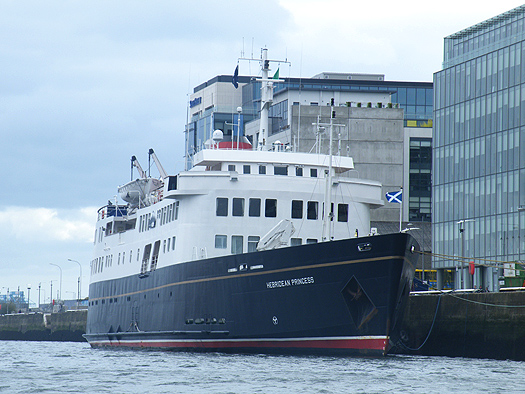
Operated by Hebridean Island Cruises, the 5-star vessel which is for only 50 guests, has a reputation for exceptional service, fine dining and has a crew of 38. Accommodation is in thirty spacious, elegant and well-appointed cabins. On Princess Deck is located 'The Isle of Arran' (for deck plans click HERE) Suite which at 340sq ft is the largest and most expensive. The suite comprises a large separate dayroom, a spacious bedroom and a luxuriously equipped Victorian-style marble bathroom. In addition 10 cabins are designed especially for the single traveller. She has appeared in 1st place in UltraTravel Magazine's "10 Coolest Cruises"
Normally the Glasgow registered vessel operates throughout the Scottish highlands and islands, to lochs and remote mainland locations made accessible due to her small size. It is in these same waters that the Hebridean Princess has sailed in another guise as the humble car-ferry Columba (photos) for Caledonian MacBrayne. She was built in 1964 by Hall Russell, Aberdeen and served in this role until 1989 when she was sold and underwent an extensive conversion for the ultra-luxury cruise market.
Her three-day stay to Dublin is part of a Grand Celtic Cruise which started in Cardiff and which will include a call to Carlingford Lough tomorrow, followed by Strangford Lough, Bangor, Ballycastle, the Scottish isles of Jura and Crinan before disembarking in Oban, her home-port. The 10-night cruise inclusive of three-gala dinners cost €4,195 per person for a double cabin and €6,292 per person in a single-cabin.
A decade before Columba was launched, the Royal Yacht Britannia (5,682 tonnes) was commissioned in 1954. She was laid-down two years previously at John Brown & Co. Ltd, Clydebank and the year before she entered service she was launched by HM Queen Elizabeth II. For over four decades she served as the royal yacht until decommissioned in 1997. Her final foreign mission was to convey the last governor of Hong Kong and Prince of Wales from the former colony after its handover to China. She is now permanently moored as an exhibition ship in Edinburgh (Leith) for details click HERE.
Earlier this month Queen Elizabeth's namesake the 2010 built Cunard Line cruiseship Queen Elizabeth made her maiden Irish call to Dublin followed by Cork (Cobh). To read more on Dublin call click HERE and for Cork (Cobh) click HERE.
- Dublin Bay
- Dublin Port
- Dublin Docklands
- Cobh
- Cruise Liners
- Ports and Shipping
- Queen Elizabeth II
- Cruiseships
- Cunard Line
- The Convention Centre
- Cruise news
- Hebridean Princess
- Hebridean Princess Cruises
- Columba ferry
- Caledonian MacBrayne
- Hall Russell Shipyard
- Royal Yacht Britannia
- Hong Kong handover
- Prince of Wales
- Royal Yacht
Rugby World Cup Coverage for Fans on Cruise-Ships
A total of 24 matches are being shown, starting from the opening game and will include all four Home Nations' matches, quarter-finals, semi -finals, bronze final and then the final on 23rd October. Of course there will be other fans on board from Wales, Scotland, England and elsewhere watching the fixtures throughout the cruise-ships various sporting bars, pubs and other venues.
Carnival Corporation's UK entertainment services general manager, Paul Wright, said: "The Rugby World Cup is of great interest to many of our passengers and we're pleased that nobody will miss out by being on holiday with us throughout this time. At any one time we could have more than 19,000 passengers collectively on board and rooting for one of the Four Nations to bring home the trophy".
He added: "Most people have a sport that they follow and some times, like on a cruise ship, you won't have access to your favourite sport, which means a lot to fans. On our last cruise on Independence of the Seas, we had popular sports shown in state rooms and certain bars around the ship, of course football was the most common sport shown".
Incidentally Independence of the Seas has also called to Cobh since her Irish debut in 2007 and at 154,407 tonnes is the largest ever cruise-caller to Cork Harbour. She surpasses Cunard Line's flagship Queen Mary 2 of 148,528 tonnes which too berthed at Cobh last Wednesday, four days after Queen Elizabeth's inaugural visit.



























